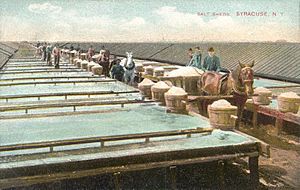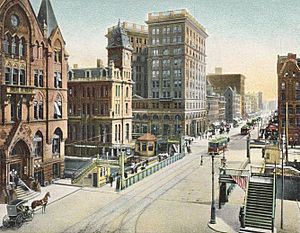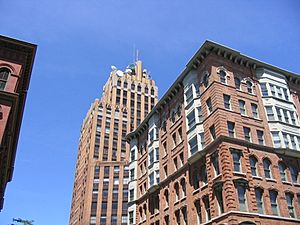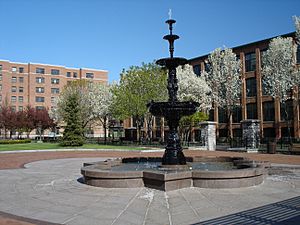History of Syracuse, New York facts for kids
| Historical population | |||
|---|---|---|---|
| Census | Pop. | %± | |
| 1850 | 22,271 | — | |
| 1860 | 28,119 | 26.3% | |
| 1870 | 43,051 | 53.1% | |
| 1880 | 51,792 | 20.3% | |
| 1890 | 88,143 | 70.2% | |
| 1900 | 108,374 | 23.0% | |
| 1910 | 137,249 | 26.6% | |
| 1920 | 171,717 | 25.1% | |
| 1930 | 209,326 | 21.9% | |
| 1940 | 205,967 | −1.6% | |
| 1950 | 220,583 | 7.1% | |
| 1960 | 216,038 | −2.1% | |
| 1970 | 197,208 | −8.7% | |
| 1980 | 170,105 | −13.7% | |
| 1990 | 163,860 | −3.7% | |
| 2000 | 147,306 | −10.1% | |
| 2010 | 145,170 | −1.5% | |
Syracuse is a city in Central New York. It was built on land that once belonged to the Onondaga Nation. The city became official in 1825. For the past 200 years, Syracuse has been an important meeting point. First, it was on the Erie Canal and its smaller canals. Later, it became a key part of the railway network.
Syracuse grew because of its salt and chemical industries. Later, it became a center for making things (manufacturing) and engineering. Even though these industries have become smaller, Syracuse is still important. It is the main place for business and education in Central New York. This region has over a million people. However, the number of people living in Syracuse itself has been going down since the 1950s.
Contents
Early History of Syracuse
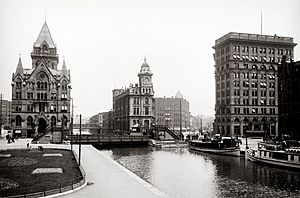
Europeans first saw the Syracuse area in the 1600s. French missionaries arrived then. A group of Jesuit priests, soldiers, and fur traders called coureurs des bois set up a mission. The Onondaga Nation, part of the Iroquois confederacy, invited them. This mission was called Sainte Marie de Gannentaha. It was located on the northeast shore of Onondaga Lake.
The mission did not last long. The Mohawk Nation warned the Onondaga to end their ties with the French. The men at the mission heard this and left by night. They had been there for less than two years. Today, you can find the remains of the mission under a restaurant in Liverpool, NY. A museum there now shows what the mission was like.
Settlers and Salt Springs
After the Revolutionary War, more settlers came to the area. They mostly came to trade with the Onondaga Nation. Ephraim Webster and Asa Danforth, who were Revolutionary War heroes, settled there in 1784. Comfort Tyler, a skilled engineer, arrived four years later. All three settled in Onondaga Hollow, south of the city center. This area was marshland at the time.
Jesuit missionaries visited the Syracuse region in the mid-1600s. They reported finding brine (salty water) springs. These springs were around the southern end of "Salt Lake," which is now Onondaga Lake. In 1788, a special agreement called the Treaty of Fort Stanwix was made. This agreement, and later a state rule, set aside the area as the Onondaga Salt Springs Reservation.
This allowed people to start making salt for money. This happened from the late 1700s to the early 1900s. The brine came from wells that tapped into salt beds. These beds were found in the Salina shale near Tully, New York. This town is 15 miles south of Syracuse. The salty water from Tully flows north. This is why there are salty springs along the shore of Onondaga Lake. Because of this fast-growing salt industry, Syracuse became known as "The Salt City."
Syracuse in the 19th Century
Syracuse had many different names before 1824. It was first called Salt Point in 1780. Then it was Webster's Landing (1786), Bogardus Corners (1796), Milan (1809), South Salina (1812), Cossits’ Corners (1814), and Corinth (1817). The U.S. Postal Service did not allow the name Corinth. They said another town in New York already had that name. So, the name Syracuse was chosen. It was named after Syracuse, Sicily, in Italy. Both cities had a salt industry and a nearby village named Salina.
In 1825, the Village of Syracuse officially became a village. Five years later, the Erie Canal was finished. This canal ran right through the village. The Village of Syracuse and the Village of Salina joined together. They formed the City of Syracuse on December 14, 1847. Harvey Baldwin became the first mayor of the new city.
Early Industries and Growth
The opening of the canal greatly increased salt sales. It made transportation cheaper. Also, the canal helped New York farms change what they grew. They started raising more pigs, and curing pork needed a lot of salt. Until 1900, most of the salt used in the United States came from Syracuse. As salt production grew, the process became more machine-based. Other industries also started to grow. The population of Syracuse grew from 250 people in 1820 to 22,271 in 1850.
The first Solvay Process Company plant in the United States opened in 1884. It was on the southeastern shore of Onondaga Lake. The nearby village was named Solvay, New York, after its inventor, Ernest Solvay. In 1861, he created a new way to make soda ash. This process used salt from wells and limestone. The Syracuse Solvay plant helped a large chemical industry grow in the city. However, this plant also made Onondaga Lake one of the most polluted lakes in the country.
Later, in 1938, large amounts of natural soda ash were found in Wyoming. This made the Solvay process too expensive to use in the U.S. The Syracuse Solvay Process Company plant closed for good in 1985. No such plants operate in North America today. However, the Solvay process is still used in many other parts of the world.
Salt mining in the Syracuse region ended in the early 1900s. This was when the Onondaga Salt Springs Reservation closed. Even so, salty water still flows from underground. It comes from a thousand feet below the Tully valley. This water feeds salt springs around Onondaga Lake.
Fighting Slavery: The Underground Railroad
Syracuse became a very active center for the abolitionist movement. This movement worked to end slavery. Key people like Gerrit Smith and his friends helped a lot. Many of them were part of the Unitarian Church and their pastor, Samuel May. Quakers in nearby Skaneateles also supported them. Many other religious groups helped too.
Before the Civil War, Syracuse was known as a "great central depot" on the Underground Railroad. This was a secret network that helped enslaved people escape to freedom. Jermain Wesley Loguen and others bravely broke federal laws to help. On October 1, 1851, a freed slave named William Henry, also known as "Jerry," was arrested. He was arrested under the Fugitive Slave Law.
The anti-slavery Liberty Party was holding a meeting in the city. When people heard about Jerry's arrest, hundreds of abolitionists rushed to help. They broke into the city jail and freed Jerry. This event became famous as the "Jerry Rescue." After this, a minister named Samuel Ringgold Ward had to escape to Canada. He was involved in helping Jerry.
Industry and Education Growth
The salt industry became less important after the Civil War. But a new manufacturing industry grew in its place. Many businesses and stores started in the late 1800s and early 1900s. These included the Franklin Automobile Company, which made the world's first air-cooled engine. The Century Motor Vehicle Company and the Craftsman Workshops also started. The Craftsman Workshops were the center of Gustav Stickley's famous handmade furniture.
Syracuse University was officially started in 1870. It began as a Methodist-Episcopal school. The Geneva Medical College was founded in 1834. Today, it is known as Upstate Medical University. It is a very respected medical school in the Syracuse area. It is one of only four medical schools in the State University of New York system. It is also one of only five medical schools in New York State outside of New York City.
Syracuse in the 20th Century
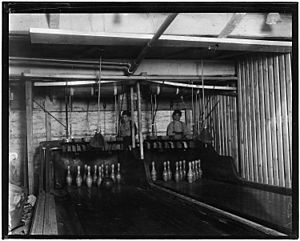
By the 20th century, Syracuse University had grown a lot. It started as a few classrooms downtown. Now it is a big research school. It is well-known across the country for its college basketball, college football, and college lacrosse teams. In 1911, the New York State College of Forestry was restarted. It worked closely with Syracuse University. This college is now called the SUNY-ESF. Other colleges also opened: Le Moyne College in 1946 and Onondaga Community College in 1962.
World War II caused industries in Syracuse to grow a lot. Companies making special steel, fasteners, and custom machines expanded. After the war, two big car companies, General Motors and Chrysler, had large operations here. Syracuse was also home to Carrier Corporation and Crouse-Hinds, which made traffic signals. General Electric had its main television factory here.
Syracuse's population reached its highest point in 1950, with 221,000 people. At that time, most people were White (97.7%) and a smaller number were African American (2.1%). Many new groups of people came to the city from other countries. These included German, Irish, Italian, and Polish immigrants. African Americans had lived in Syracuse since the Revolutionary War. Between 1940 and 1960, many African Americans moved from the southern U.S. to northern cities like Syracuse. In the 1980s, many immigrants from Africa and Central America also moved to Syracuse. Sometimes religious charities helped them.
However, these new residents could not make up for the people leaving Syracuse. Many moved to the suburbs or out of state because of job losses. The city's population slowly goes down each year.
Many parts of the city changed after World War II. Pioneer Homes, one of the first government housing projects in the U.S., was finished in 1941. Many of Syracuse's important old buildings were torn down in the 1950s and 1960s. A federal program called Urban Renewal cleared large areas. These areas remained empty for many years. However, some new museums and government buildings were built.
The manufacturing industry in Syracuse began to struggle in the 1970s. Many small businesses closed. This led to more people being out of work. Rockwell International moved its factory out of the state. General Electric moved its television factories first to Suffolk, Virginia, and then to Singapore. The Carrier Corporation moved its main office out of Syracuse. It also moved its manufacturing to Asian countries. Even though the city's population has gone down since 1950, the population of the Syracuse metropolitan area has stayed about the same. It has even grown a little since 1970. This growth is better than in many other parts of upstate New York, but it is slower than the national average.


